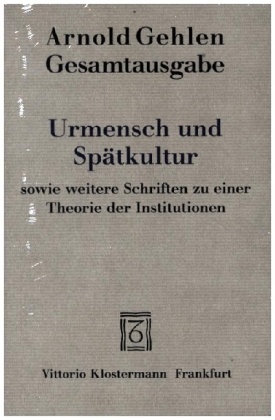
Urmensch und Spätkultur sowie weitere Schriften zu einer Theorie der Institutionen
| Verlag | Klostermann |
| Auflage | 2022 |
| Seiten | 700 |
| Format | 13,7 x 3,8 x 20,9 cm |
| Gewicht | 755 g |
| Reihe | Arnold Gehlen Gesamtausgabe 5 |
| ISBN-10 | 346502799X |
| ISBN-13 | 9783465027997 |
| Bestell-Nr | 46502799A |
Das 1956 erstmals erschienene Buch "Urmensch und Spätkultur" ist vor allem ein soziologisches Grundlagenwerk zur Philosophie der Institutionen. Es wird in diesem Band ergänzt um weitere Aufsätze zu einer Theorie der Institutionen. Die Gründung von Institutionen ist für Gehlen aufs Engste mit der Vergegenständlichung von magischen Vorstellungen durch gemeinschaftliche, symbolisch besetzbare Handlungsvollzüge verbunden. Die elementarsten Formen solchen Verhaltens fand der Autor in der Beobachtung früher, schriftloser Gesellschaften. Daraus schloss Gehlen, dass sich in gemeinschaftlichen Interaktionen immer auch eine »Transzendenz ins Diesseits« vollziehe, also die Vergegenständlichung des sonst Unsichtbaren. Für Gehlen sichern Institutionen das indirekte Verhältnis, welches Menschen zu anderen und zu sich selbst aufzubauen gezwungen sind. Gehlen sah in diesen »Sozialregulationen« unwahrscheinliche und mühsam erreichte Stabilisierungen, deren geschichtlich legitimierte Ordnungsleistu ngen sich seit der Aufklärung, den großen Revolutionen und spätestens seit dem 20. Jahrhundert zunehmend aufgelöst hätten. Der Geltungsverlust der Institutionen im Zeitalter der von ihm so genannten Post-Histoire galt Gehlen als schicksalhaft. Was im Titel des vorliegenden Buches als »Spätkultur« bezeichnet wird, meint vor allem einen zunehmenden Subjektivismus sowie einen Zustand, in dem die komfortabel entlastenden Automatismen der Massenproduktion und -versorgung der Ansicht zur Gültigkeit verholfen hätten, dass der Zweck allen Handelns die Vermeidung von Unlust und die Erregung von Lust sei.Arnold Gehlen's seminal socio-anthropological study "Urmensch und Spätkultur", first published in 1956, is primarily a work on the philosophy of institutions. In this edition, it is supplemented by further essays on a theory of institutions. For Gehlen, the foundation of institutions is closely connected with the objectification of magical ideas and practices by means of communal, symbolica lly meaningful actions. Gehlen detected the most elementary forms of such behavior in the observation of early, scriptless societies. From this Gehlen concluded that communal interactions enact a "transcendence into this world", i.e. the objectification of the otherwise invisible. For Gehlen, institutions serve to secure the indirect relationship humans are forced to establish with others as well as with themselves. In these "social regulations", Gehlen saw improbable and painstakingly achieved stabilizations, the binding character and thus the impact of which had increasingly dissolved since the Enlightenment, the great revolutions, and at the latest since the 20th century. The progressive diminishing of the validity of institutions in the age of what he called post-histoire was regarded by Gehlen as fateful. What is called "late culture" in the title of the present book signifies an increasing subjectivism as well as a state in which the comfortably relieving automatisms of mass production and corresponding mass supply fostered the widespread conviction that the purpose of all action was the avoidance of displeasure, aversion and pain in order to yield lustful sensations.
